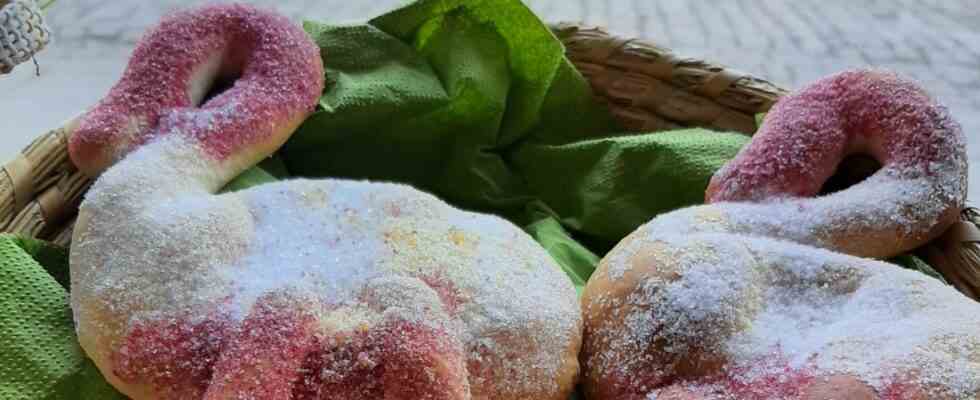The eggs, the rabbit, the chocolate and going to church, for some still the end of Lent. So far, so traditionally Easter, or sometimes not at all. On the other hand, the following five Bavarian Easter traditions are less well known.
The Easter laughter: Laugh? In the church? Just at Easter? Yes, explains Pastor Reinhard Röhrner, this custom has existed since the 14th century. Sometimes for social criticism, sometimes to express Easter joy. A good 400 years later, a ban followed by decree, but laughter in church is experiencing a rebirth, including at Röhrner in Kelheim – appropriately every year at Easter. “It’s not about teasing any dirty things,” says Röhrner, who months ago tested this year’s joke for his community as inconspicuously as possible. “But if I can laugh at Easter, then death, which is overcome, has lost its horror.”
A unique product made of yeast dough: they have been baking the Easter stork in Ostheim since 1683.
(Photo: Juliane Witthauer)
The Easter Stork: In Ostheim in Lower Franconia (and in parts of Thuringia) the stork brings the Easter eggs – traditionally on Maundy Thursday. According to legend, a Protestant pastor wanted to stand out from the surrounding Catholic communities and their fasting pretzels. So he decided to use the life-giving storks, which return at Easter time, as an Easter symbol – and so this Wednesday evening, master baker Juliane Witthauer and her family begin to form storks out of yeast dough, to put them in the oven at night, to decorate them with colored sugar and finally to sell. Since 1683, since the shop closed a few years ago, they have only been baking here at Easter and only the birds. “So that every child in Ostheim will continue to have a stork.”
One on the manure heap, one on the ants: In the “Magic Book” from Münchberg in Upper Franconia it is written down what happens to the Maundy Thursday eggs.
(Photo: City Archive Münchberg)
Maundy Thursday eggs: “Eggs that were laid on Maundy Thursday were about the most powerful thing you could imagine,” says local researcher Adrian Roßner, because: Maundy Thursday is considered to be beneficial because of the indulgence of sins; at Easter life, the return of the power of nature is celebrated; and eggs represent new life. This pregnant clutch, known as Maundy Thursday egg, landed on a dung heap in Franconia every Easter up to the 20th century – a stone was supposed to grow from it to defend one’s own body. This is what it says in several “magic books” from Münchberg. A second egg belonged in an old hen’s nest and should bring wealth, a third on an anthill, where it should turn into a red stone that wards off all suffering. According to Roßner, people kept Maundy Thursday eggs all year round and used them in a variety of ways.
The Easter Firewalking: In Christianity, light and fire are even more symbolically charged than the egg. Daniela Sandner from the Bavarian Association for Homeland Care calls it the “ultimate symbol of the resurrection of Jesus”. Since the 12th century, people have lit bonfires dedicated to Easter, buried the coals in their fields for a rich harvest or mixed them with animal feed. The custom of the Easter fire also gave rise to the anti-Semitic Judas fire or the Easter fire walk, an Upper Bavarian specialty: young men sprint through the village with tree sponges lit at the Easter fire and throw parts of them into the hearth to bring blessings.
Twelve eggs first for Easter, clothes, jewellery, a myrtle branch and a pewter plate for confirmation: in the 1970s, a boy in Glashütten in Upper Franconia received a bundle of godparents.
(Photo: Horst and Lilo Schröder, Collection Adrian Roßner)
The patent goods: Since the 18th century, godparents have been putting twelve eggs – some cooked, some raw – on their godchild’s table for their first Easter. If this child grabs a red painted one, it brings luck – at least that’s how the story goes – a blue one means wealth and a white one means death before confirmation. “But of course the eggs are draped in such a way that the child can hardly take a white one,” explains Adrian Roßner. In the past, godparents were even more important, they were “guarantors for the salvation of the soul” and would have served the godchild twelve eggs again until confirmation every Easter. In the year of confirmation, they brought other godparent goods instead of eggs: clothing, jewellery, a myrtle branch, once a pewter plate and today money.

